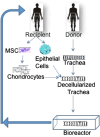Translating tissue-engineered tracheal replacement from bench to bedside
- PMID: 20730554
- PMCID: PMC11115688
- DOI: 10.1007/s00018-010-0499-z
Translating tissue-engineered tracheal replacement from bench to bedside
Abstract
There are a variety of airway diseases with different clinical settings, which may extend from a surgical approach to total organ replacement. Tissue engineering involves modifying cells or tissues in order to repair, regenerate, or replace tissue in the body and seems to be a promising approach for airway replacement. The successful implantation of stem-cell-based tissue-engineered trachea in a young woman with end-stage post-tuberculosis left main bronchus collapse serves as a prototype for the airway tissue-engineered-based approach. The trachea indeed could represent a perfect model system to investigate the translational aspects of tissue engineering, largely due to its low-oxygen needs. This review highlights the anatomy of the airways, the various disease conditions that cause damage to the airways, elaborates on the essential components of the tissue-engineering approach, and discusses the success of the revolutionary trachea transplantation approach.
Figures





Similar articles
-
Airway tissue engineering: an update.Expert Opin Biol Ther. 2014 Oct;14(10):1477-91. doi: 10.1517/14712598.2014.938631. Epub 2014 Aug 7. Expert Opin Biol Ther. 2014. PMID: 25102044 Review.
-
Tissue engineering technologies: just a quick note about transplantation of bioengineered donor trachea and augmentation cystoplasty by de novo engineered bladder tissue.G Chir. 2009 Nov-Dec;30(11-12):514-9. G Chir. 2009. PMID: 20109384 Review.
-
Clinical Translation of Tissue Engineered Trachea Grafts.Ann Otol Rhinol Laryngol. 2016 Nov;125(11):873-885. doi: 10.1177/0003489416656646. Epub 2016 Jul 12. Ann Otol Rhinol Laryngol. 2016. PMID: 27411362 Free PMC article. Review.
-
Airway tissue engineering.Expert Opin Biol Ther. 2011 Dec;11(12):1623-35. doi: 10.1517/14712598.2011.623696. Epub 2011 Oct 6. Expert Opin Biol Ther. 2011. PMID: 21973083
-
Stem cell-based organ replacements-airway and lung tissue engineering.Semin Pediatr Surg. 2014 Jun;23(3):119-26. doi: 10.1053/j.sempedsurg.2014.04.002. Epub 2014 Apr 18. Semin Pediatr Surg. 2014. PMID: 24994525 Review.
Cited by
-
Decellularized extracellular matrix-loaded exosome hydrogel for cell-free tracheal scaffold in tracheal defect reconstruction and repair.J Nanobiotechnology. 2025 Apr 15;23(1):289. doi: 10.1186/s12951-025-03328-8. J Nanobiotechnology. 2025. PMID: 40229874 Free PMC article.
-
Advances in tracheal reconstruction.Plast Reconstr Surg Glob Open. 2014 Aug 7;2(7):e178. doi: 10.1097/GOX.0000000000000097. eCollection 2014 Jul. Plast Reconstr Surg Glob Open. 2014. PMID: 25426361 Free PMC article. Review.
-
Psidium guajava L. phenolic compound-reinforced lamellar scaffold for tracheal tissue engineering.Drug Deliv Transl Res. 2024 Jan;14(1):62-79. doi: 10.1007/s13346-023-01381-0. Epub 2023 Aug 11. Drug Deliv Transl Res. 2024. PMID: 37566362 Free PMC article.
-
[In vitrodifferentiation of human amniotic mesenchymal stem cells into ligament fibroblasts after induced by transforming growth factor β 1 and vascular endothelial growth factor].Zhongguo Xiu Fu Chong Jian Wai Ke Za Zhi. 2017 May 15;31(5):582-593. doi: 10.7507/1002-1892.201612090. Zhongguo Xiu Fu Chong Jian Wai Ke Za Zhi. 2017. PMID: 29798549 Free PMC article. Chinese.
-
Decellularization of Trachea With Combined Techniques for Tissue-Engineered Trachea Transplantation.Clin Exp Otorhinolaryngol. 2019 Feb;12(1):86-94. doi: 10.21053/ceo.2018.00486. Epub 2018 Oct 18. Clin Exp Otorhinolaryngol. 2019. PMID: 30326701 Free PMC article.
References
-
- Des Jardins T. Cardiopulmonary anatomy and physiology: essentials for respiratory care. New York: Delmar; 2007.
-
- Fishman AP, Elias JA, Fishman JA, Grippi MA, Senior RM, Pack AI. Fishman’s pulmonary diseases and disorders. Columbus: McGraw-Hill Professional; 2008.
-
- Cardoso WV, Lu J. Regulation of early lung morphogenesis: questions, facts and controversies. Development. 2006;133:1611–1624. - PubMed
-
- Okubo T, Knoepfler PS, Eisenman RN, Hogan BL. Nmyc plays an essential role during lung development as a dosage-sensitive regulator of progenitor cell proliferation and differentiation. Development. 2005;132:1363–1374. - PubMed
-
- Kim CF, Jackson EL, Woolfenden AE, Lawrence S, Babar I, Vogel S, Crowley D, Bronson RT, Jacks T. Identification of bronchioalveolar stem cells in normal lung and lung cancer. Cell. 2005;121:823–835. - PubMed
Publication types
MeSH terms
LinkOut - more resources
Full Text Sources
Other Literature Sources

